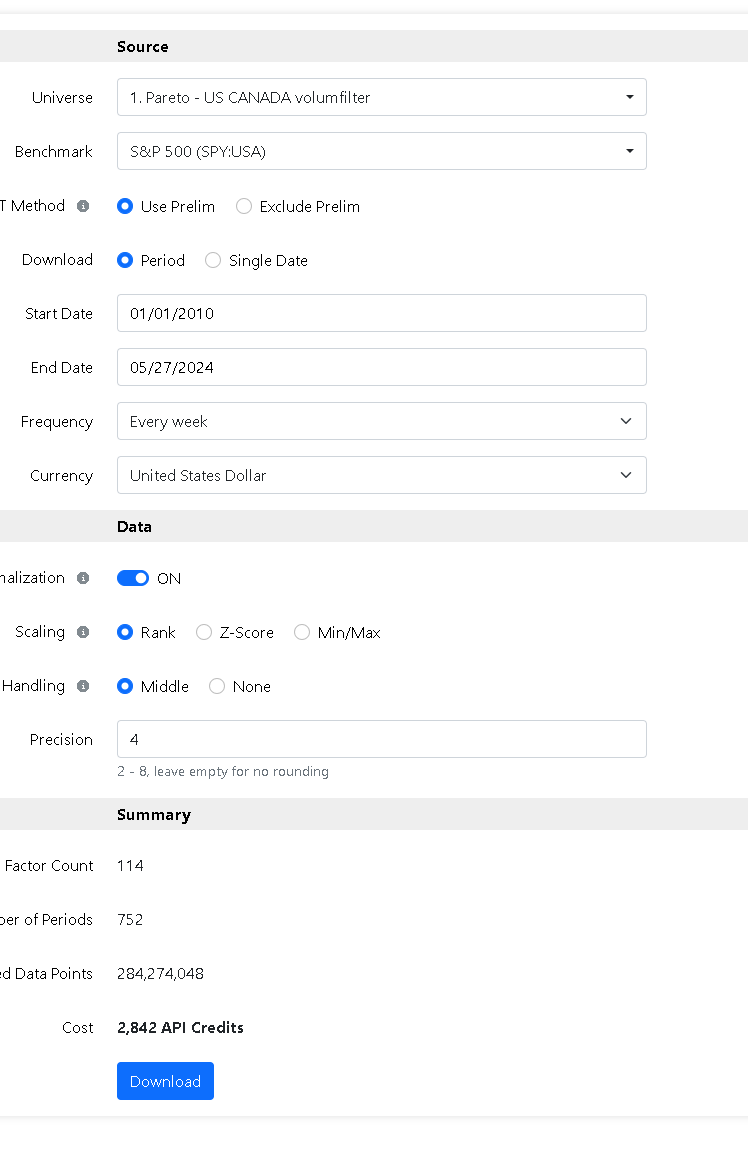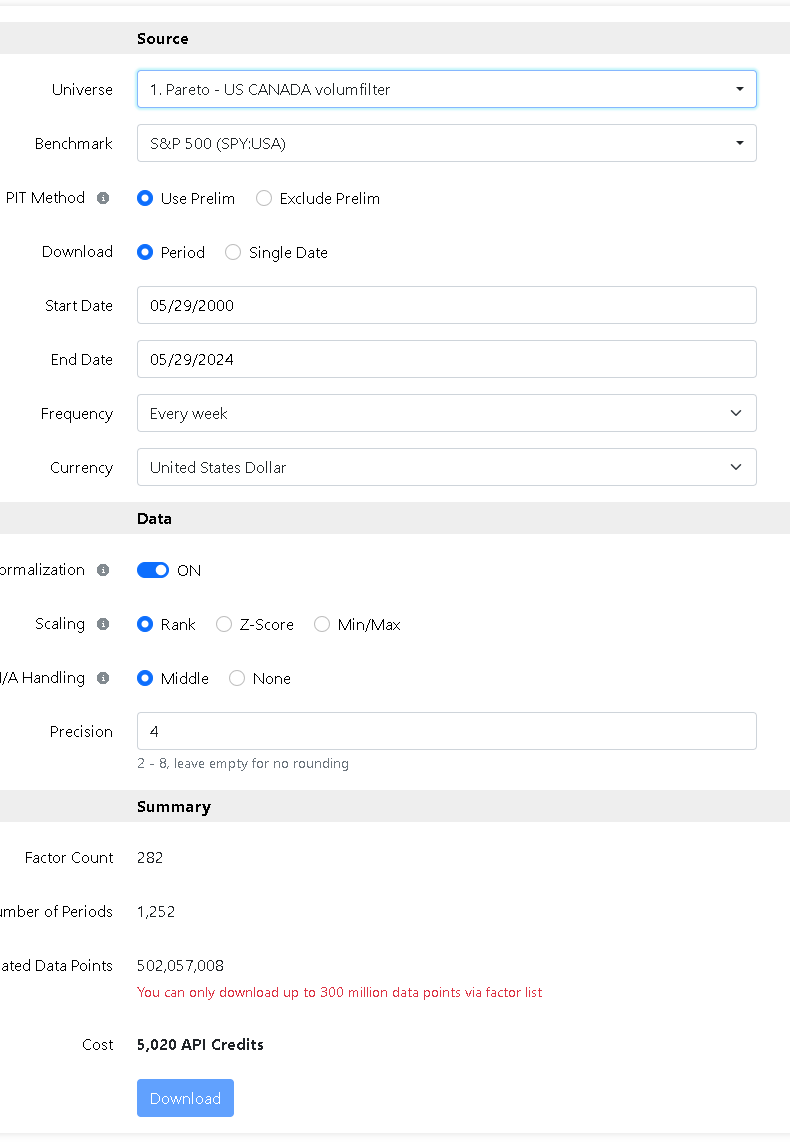TL;DR: The answer to the above question, I think, is you can download data that is updated overnight using the API or if you rebalance weekly you can use Data -> Download factors. You can then use that data at home to make predictions with machine learning using your own computer or Colab. If you are just looking for the most cost-effective way to do machine learning at P123 for most people you can safely ignore the rest of this post.
This method is well-summarized here:
So again, you can just stop here if you want to know what will be most cost-effective for most members. You already have that. But here is a rough—back of the envelope--assessment of the costs for this method versus using P123's AI/ML for those interested in some numbers.
I am not an accountant (or programmer), but member cost for using downloads:
-
Home computer and/or Colab, AWS or other provider which many already have.
-
API credits with Ultimate membership. The Ultimate membership probably providing enough API credits to rebalance and do some training. Maybe the purchase of some API credits during initial training will be required.
-
Some member programming time setting up the API to rebalance (as detailed above by Pitmaster). People can asses the value of their time without me.
P123 cost:
-
The cost of providing the API downloads which is often billed to the member or part of one of the higher memberships.
-
Considerable reduction in the use P123 servers no matter how members might substitute outside computer resources for P123 servers using the AI/ML or P123 Classic.
Of course, P123 will be releasing a new AI/ML option.
P123 member cost: Can be summarized as $1,200 per year additional cost is now being considered by P123.
-
Minimum of $1,200 if you train a model and want to fund it. $1,200 if you want to rebalance it, in other words.
-
Probably an Ultimate Membership if you want to train a model but an Ultimate membership is probably necessary to use the API method also, so not necessarily an additional cost when comparing the 2 methods.
Cost to P123:
- Mainly increased cost for any increased use of the present servers that create sims and rebalance. The new severs cost $1.50 per hour and some of this will be charged to the P123 member as resource units so that is not a significant expense from what I understand.
Savings:
- So most of the training, at least, occurs on a server that costs $1.50 per hour and this is charged to the member as RUs (resource units), so some of this cost is billed to the user. Some RUs are provided with an Ultimate Membership. Members will not be using the Sim Servers as much. But they may move over to the Sims for their training of models at some point. Not 100% sure how that will work. Rebalance, for now, seems to involve the more expensive servers and be extremely costly for some reason that I can quite figure out (my lack of programming skill being the obvious reason). In any case, rebalancing is the primary cost to the member and I assume it is associated with significant cost to P123.
So this can be summarized (again) as: Pitmaster's way will save me $1,200 per year. I already have a machine that can do this at home with the API. There are a few things my machine cannot do. Support Vector Machines do not run fast enough, for example. But I will have complete control over the program at home as an advantage separate from the costs.
Or course this assumes a person believes there is a real, practical benefit to machine learning and has a desire to use it as a member or someone considering becoming a member has a desire to do machine learning
I note that Yuval is pretty computer savvy (at least knows P123's programming better than almost anyone). And can crunch the numbers to know what works for him and the factors he used. I assume someone was there to help him with things he was not familiar with.
AND I do think someone can actually do machine learning (using Python programs that are generally called machine learning by most people) to optimize the rank weights in P123 Classic and that seems to work for me. Call that whatever you want. I don't care about the name as long as it works and is automated. Plus, rebalancing P123 Classic is easy in addition to being less expensive.
I am not in charge of marketing but I think P123 will need to attract new customers who already have an appreciation for machine learning to succeed. Maybe they will remain committed to machine learning while reading the forum. The present members are not likely to give it adequate support in the forum or be convinced to pay the additional price themselves. See above quote from P123 staff that is a reflection of much of the sentiment P123 members have at this point in time, I would guess. To be clear, I think it was an honest assessment by an advanced user and I don't disagree that P123 Classic works for many people including me.
For new members interested in machine learning specifically, it will be $3,200 per year (counting the Ultimate Membership) to just try machine learning with the AI/ML. And even then, they would have to have just the right level of programming skill (or lack of programming skill) to chose the AI/ML over using the API. Some will move to P123 classic eventually for various reasons.
While machine learning at P123--as well as many features including k-fold validation--may have been my idea originally, I only made a feature suggestion for the downloads (specifying the array for the download in my posts) which can be done now with the API. The idea that ranks could be used for machine learning was not accepted for a while by P123. I was not consulted by P123 about the AI/ML offering, ever. I am not arguing against my own ideas is the point. However, I do think a different price structure--creating a demand from new customers who actually believe in machine learning with their posts reflecting that appreciation in the forum---will work well for P123's AI/ML offering long-term. But none of that is guaranteed.
From what i understand about the AI/ML Marco has done an excellent job with it. I think that it will work well, has advance capabilities (e.g., an excellent, state of the art, method of cross-validation) and it will be easy to use--even for those not experienced in machine learning now. I will gratefully take advantage of the AI/ML offering when (not if) the cost/benefit ratio is clearly in favor of doing so.
Jim

